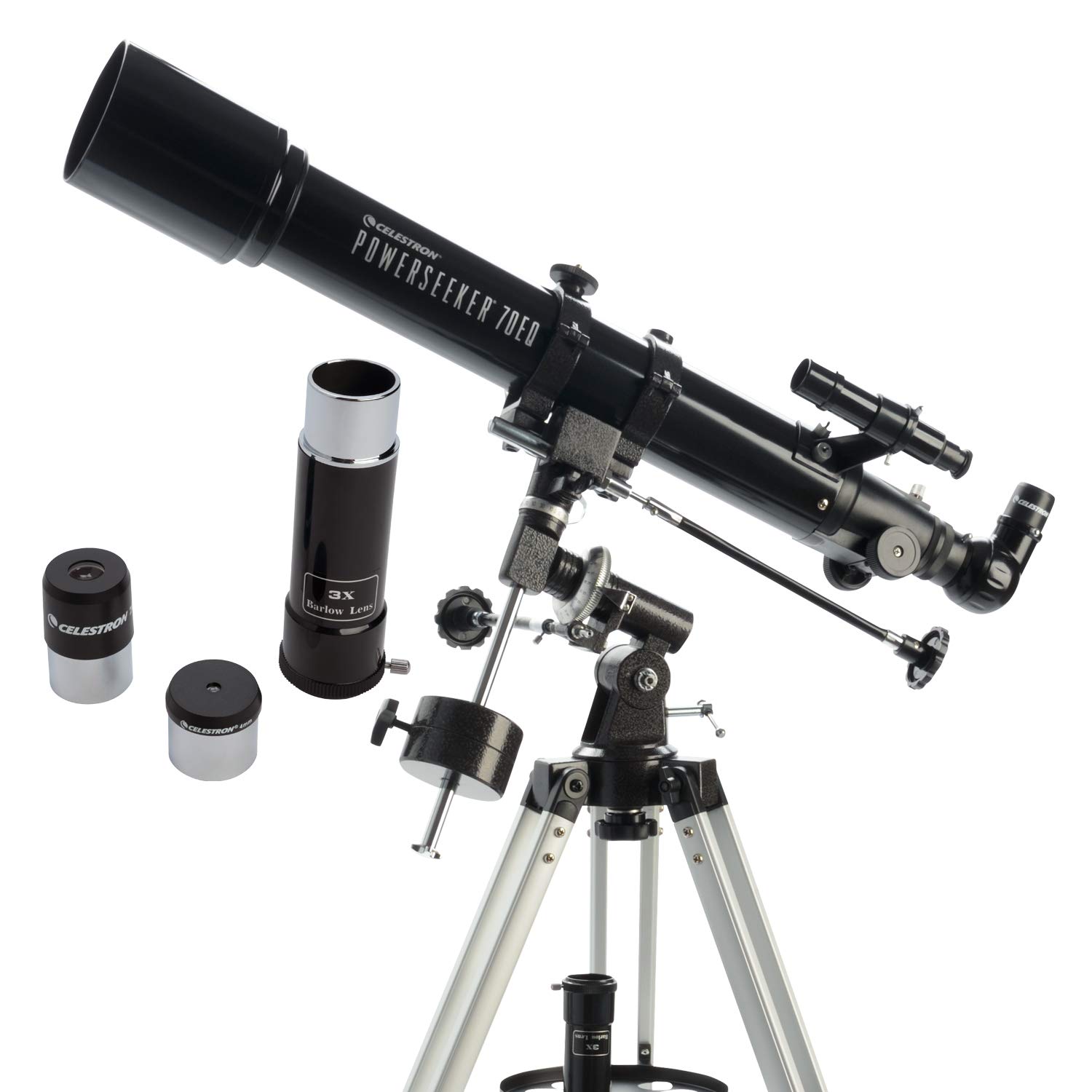Trying to find a telescope that doesn’t empty your wallet but still actually works? The PowerSeeker 70EQ might just fit the bill. Celestron’s refractor telescope strikes a pretty nice balance between features and affordability, especially for anyone just dipping their toes into astronomy.
Celestron packs in a German equatorial mount, which makes tracking moving objects across the sky a lot easier. You’ll get two eyepieces and a 3x Barlow lens, so you can really play around with your magnification options.
People say this scope shows off the Moon’s craters, Jupiter’s moons, and Saturn’s rings pretty well. It’s lightweight and portable, so you can toss it in the car for a camping trip or drive out to darker skies. Some folks wish the tripod felt sturdier, and the finder scope can be a pain to use until you get the hang of it.
Overview of the Celestron PowerSeeker 70EQ Telescope
This entry-level refractor is aimed at beginners who want to start exploring astronomy without spending a fortune. The PowerSeeker 70EQ combines a 70mm aperture and a German equatorial mount.
Key Features:
- 70mm aperture for decent light gathering
- German equatorial mount with slow-motion controls
- Two eyepieces (20mm and 4mm) plus 3x Barlow lens
- Compact design weighing under 14 pounds
You’ll get good views of the Moon’s craters, Saturn’s rings, and Jupiter’s moons. Under darker skies, you might even spot some deep-sky objects like the Orion Nebula.
The German equatorial mount helps you track objects as they move across the sky, though some people find setting it up a little tricky at first. The accessories included add value, but the optics don’t match what you’d get from pricier models.
Some drawbacks? The plastic parts feel a bit cheap, and you won’t get great results in light-polluted areas. Aligning the finderscope can be frustrating, too.
Powerful Magnification and Optics
The optical system in the PowerSeeker 70EQ gives beginners a solid starting point. With its 70mm aperture, you’ll gather enough light to see lunar craters and bright planets like Jupiter’s moons.
Key optical features:
- 70mm aperture – Lets you see basic celestial objects
- Manual focus system – You control image sharpness
- Barlow lens included – Triples your eyepiece magnification
With the refractor design, the Moon and bright planets look crisp. The 70mm aperture does limit your deep-sky viewing, though. Saturn’s rings and Jupiter’s cloud bands show up, but don’t expect to see details in distant galaxies.
Manual focus takes a little patience. Most new users need a bit of practice to get sharp images. The included Barlow lens actually works, giving you more magnification options.
Sure, the optics don’t compete with high-end telescopes, but for learning the basics, it’s a good place to start.
German Equatorial Mount and Smooth Tracking
The PowerSeeker 70EQ’s German equatorial mount makes it easier to keep up with stars and planets as they drift across the sky.
You can use the slow-motion altitude rod to nudge the scope and keep things centered. Just move it up or down to track your target. Most beginners find this system friendly enough after a short learning curve.
Key Mount Features:
- Manual German equatorial design
- Slow-motion altitude rod for smoother tracking
- Sturdy enough for this price range
The mount feels stable enough for a budget scope, but super precise tracking takes some practice. You’ll need to get used to the controls for smooth movements.
Once you align the mount, you can track objects by moving just one axis, which comes in handy for longer viewing sessions.
User-Friendly Design and Portability
Starting out in astronomy gets a lot easier when your gear isn’t a hassle. The PowerSeeker 70EQ keeps things simple with a straightforward setup and a compact build.
Key Design Benefits:
- Lightweight so you can carry it anywhere
- Compact size fits in most cars
- Manual German equatorial mount with slow-motion controls
- Easy enough for adults and kids to use together
You can haul this telescope from the backyard to a campsite without breaking a sweat. No need for a truck or heavy lifting.
The manual mount system and slow-motion controls help you track planets and stars across the sky. It takes a few nights to get the hang of it, but once you do, you’ll keep things in view longer.
The tracking isn’t automatic, so you’ll need to adjust as you go. Not a dealbreaker, but it’s something to keep in mind while you’re learning.
Included Accessories and Astronomy Software
Celestron includes a decent starter kit with the PowerSeeker 70EQ. You get two eyepieces — a 20mm for wide views and a 4mm for higher magnification.
The 3x Barlow lens is a nice touch, letting you triple the power of each eyepiece. That gives you six magnification combos without needing to buy extras.
You also get free astronomy software as a digital download. It helps you learn the sky and plan what to look for, which is pretty handy if you’re new to all this.
The eyepieces work fine for a beginner scope, though they’re nothing fancy. The Barlow lens does its job, but you might see some color fringing at high power. The software adds some real value for learning.
With these accessories, you’ve got everything you need to start observing right away. A lot of other budget telescopes skimp on extras.
Warranty and Customer Support
Celestron backs the PowerSeeker 70EQ with a 2-year US warranty covering manufacturing defects and parts.
That warranty brings a bit of peace of mind. Celestron’s been making scopes since the 1960s, so you’re not dealing with some fly-by-night company.
Customer support highlights:
- Unlimited support from US-based experts
- Phone and email help available
- Technical assistance for setup and operation
Their support team can walk you through mounting, focusing, and any telescope hiccups. They know their stuff, since telescopes are their whole business.
Some buyers say response times slow down during busy seasons. Others had their problems solved quickly. Celestron’s long history means they’ve seen just about every common issue.
The warranty doesn’t cover drops, weather damage, or normal wear and tear.
Pros and Cons
Let’s get real about what works and what doesn’t with this telescope, based on what actual buyers say.
Pros
Value for Your Money
The PowerSeeker 70EQ packs a lot in for a budget-friendly price. You get a metal tube, tripod, and German equatorial mount for way less than some competitors.
Good for Learning
Beginners find this scope helps them figure out astronomy basics. The manual German equatorial mount teaches you how to track objects like the pros do.
Decent Viewing Power
You’ll spot planets like Venus and Jupiter, even if you’re stuck with some light pollution. The 70mm aperture is enough to show off Moon craters and bright stars.
Complete Package
You get two eyepieces and a 3x Barlow lens for lots of magnification options. The software is a nice bonus for learning.
Cons
Build Quality Issues
Some parts feel a little flimsy, especially the tripod legs and mount connections. Plastic bits might not stand up to heavy use over time.
Setup Challenges
Aligning the German equatorial mount isn’t exactly intuitive. Most beginners need a few tries before it clicks.
Limited Accessories
The included eyepieces work, but they’re pretty basic. If you stick with the hobby, you’ll probably want to upgrade.
Tracking Difficulties
Manual tracking means you’ll be making constant tweaks to keep objects in view, which can get old during long sessions.
Ready to start your stargazing journey? Check out the PowerSeeker 70EQ on Amazon to see current pricing and availability.
Customer Reviews
People seem pretty happy with the PowerSeeker 70EQ, especially for the price. Most folks mention it’s a great value. Parents often pick it up for their kids and say it’s way easier to set up than the old telescopes they remember struggling with.
What customers like:
- Easy assembly – Lots of people mention the setup is simple
- Great beginner value – Many call it the best starter telescope under $120
- Good performance – Even in places with some light pollution, users spot planets like Venus and Jupiter
- Quality construction – The metal tube and tripod actually feel sturdy for what you pay
Common concerns:
- Basic accessories – Some wish the included eyepieces were a bit better
- Learning curve – New users often have to check out online tutorials to figure out the equatorial mount
Over 2,200 buyers have given it a 4.3-star rating. People outside the US seem to like it too, and plenty recommend it to other beginners.
Thinking about getting into astronomy? Check out the PowerSeeker 70EQ on Amazon for the latest price and availability.
Best Uses and Observing Experience
You can use this telescope for all sorts of things. The PowerSeeker 70EQ lets you check out lunar craters, bright planets like Venus and Jupiter, and even a few deep-sky objects such as the Orion Nebula. That 70mm aperture brings in enough light for these targets.
The German equatorial mount lets you track objects as they drift across the sky, so you can keep planets in view longer without too much hassle. Slow-motion controls help you nudge the telescope without shaking it all over the place.
Best viewing conditions:
- Darker spots, far from city lights
- Clear nights with steady air
- Looking at objects high overhead
You won’t see super faint objects with this scope because of its smaller aperture, but it handles bright stuff like the Moon and planets really well. The eyepieces that come with it give you a couple of different magnification options.
Plenty of folks say they get good views from suburban backyards, though you’ll catch more detail in darker areas. Its portable design makes it easy to pack up and head somewhere better for stargazing.
Curious about stargazing? Check out the PowerSeeker 70EQ on Amazon for current pricing and availability.
Conclusion
So, after digging into the details, I’d say the PowerSeeker 70EQ makes a pretty solid pick for beginners. You get decent optics and a sturdy German equatorial mount, all at a price that feels pretty reasonable.
The telescope lets you check out planets and brighter objects with ease. Plenty of folks have spotted Venus and Jupiter without much hassle. The metal construction gives it a durable feel, and the included software actually adds some extra value.
Still, you’ll want to keep a few things in mind. The accessories don’t really stand out, and honestly, the 3x Barlow lens probably won’t wow anyone with experience. If you’re in a spot with a lot of light pollution, your viewing options will shrink quite a bit.
Key Points:
- Good value for beginners
- Sturdy build quality
- Basic accessories included
- Limited in high light pollution areas
Thinking about jumping into astronomy? Check out the PowerSeeker 70EQ on Amazon to see what it’s going for right now.


